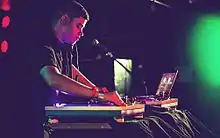Wonky (genre)
Wonky (also known as purple sound, aquacrunk, or lazer hip hop[1][2]) is a subgenre of electronic music known primarily for its off-kilter or “unstable” beats, as well as its eclectic blend of genres including hip hop, electro-funk, chiptune, jazz fusion, glitch, and crunk.[2][3] It initially emerged in 2008 from the UK's dubstep and grime scenes, exchanging their austere sound for a typically colorful or exuberant style featuring garish synthesizer tones, melodies, and effects.[1] Other influences included American hip hop producers J Dilla and Madlib. Artists associated with the style include Rustie, Joker, Hudson Mohawke, Zomby, Mimosa, MartyParty and Flying Lotus.[2][3]
| Wonky | |
|---|---|
| Stylistic origins | |
| Cultural origins | Mid 2000s–early 2010s, United Kingdom, Los Angeles |
| Regional scenes | |
| |
Regional characteristics
The "wet and unstable" sound of wonky is often achieved by producing unquantized beats and mid-range basses using pitch bending, mid-range synths, LFOs on lowpassing and highpassing, phasing, and delaying.
Though wonky music is united by the tendency to use unstable mid-range synths, every wonky music scene has its own specific traits in sound. The American wonky "street bass" scene is influenced by broken beat and jazz music and the music itself has an organic feeling,[4] while the Glasgow aquacrunk and Bristol purple sound scenes are influenced by the sound of crunk, chiptune, electro and instrumental grime/dubstep,[4] respectively.

Aquacrunk was pioneered by Glasgow artist Rustie, and features slowed down, low-slung beats influenced by Southern hip-hop with electronic mutterings and morphing basslines.[5] It is influenced as much by early Rephlex and Underground Resistance releases by crunk artists like Lil Jon or Young Buck.[5]
Purple sound emerged in Bristol in late 2008 out of the splintering dubstep scene and took inspiration from wonky, which it is sometimes considered a part of. It incorporates synth funk from the 1980s and G-funk production from the ’90s into dubstep, while also introducing many aspects of grime and chiptune (several prominent purple sound artists cite video game music as a large influence).[6] Purple sound usually includes synths as a main component and avoids the bass 'wobble' and 2-step common in dubstep. The majority of purple sound tracks are instrumental.
References
- Thomas de Chroustchoff, Gwyn. "The Dummy guide to purple". Dummy Mag. Archived from the original on 11 October 2017. Retrieved 30 December 2017.
- Martin Clark (2008-04-30). "Grime / Dubstep". Pitchfork. Archived from the original on 2018-06-12. Retrieved 2016-07-18.
- Reynolds, Simon (2011). Retromania: Pop Culture’s Addiction to Its Own Past. Farrah, Straus & Giroux. p. 76.
- "Archived copy". Archived from the original on 2008-10-21. Retrieved 2008-11-07.CS1 maint: archived copy as title (link)
- Lanre Bakare. "Scene and heard: Get ready for aquacrunk | Music". The Guardian. Archived from the original on 2014-02-04. Retrieved 2016-07-18.
- "Maintenance Mode". The Stool Pigeon. Archived from the original on 2016-03-24. Retrieved 2016-07-18.